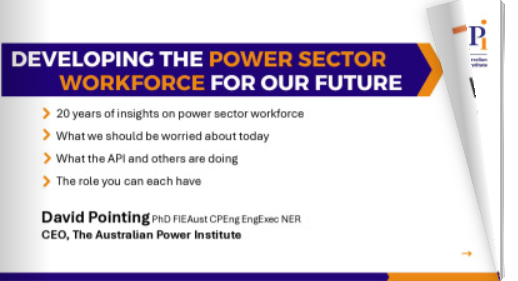Addressing the Power Sector Workforce Challenges: Insights and Actions
The API team recently presented key insights on workforce challenges and solutions to critical stakeholders across three significant events in late 2024: the EESA EECON conference, the IEEE AUPEC Power Engineering Academic's conference, and the IEEE IAS INDUSTRY-ACADEMIC LEADERSHIP WORKSHOP 2024 — ARC Future Grids Training Centre.
These discussions highlighted the urgent need to address the workforce gap and foster innovation in education, training, and industry practices to secure the future of Australia’s power sector.
Insights for Industry professionals: presentation at the EESA Conference (19 November 2024): Industry Engagement
The presentation at the EESA conference focused on identifying and ranking the top five workforce challenges as determined by feedback from 137 industry respondents and sharing recent data on projections for the numbers of people needed in the power engineering workforce moving forward.
This data was sourced from the RACE for 2030 CRC's recent report on "Electricity sector workforce projections for the 2024 Integrated System Plan and for Australia | RACE for 2030", led by Jay Rutovitz at UTS.
The key challenges include:
Number of power engineering professionals: A critical shortage is being felt across the sector.
What we teach/train: Ensuring alignment between academic programs and industry needs.
How we train enough, fast enough: Adapting training to meet industry timelines.
Delivery issues: Balancing training needs with ongoing operational demands.
Skill-specific demand variability: Addressing fluctuations in the need for specific skills.
Call to Action for Industry:
Actively engage in workforce initiatives and mentorship programs.
Provide input on curriculum design to ensure alignment with industry needs.
Support initiatives to attract more students into power engineering through visibility and relevance, especially with messages like, "Want to save the world? Become a power engineer."
Insights for teaching university academics: shared at the AUPEC Conference (21 November 2024): Academic Perspectives
At the AUPEC conference, the API team highlighted data showing that the two highest-rated workforce issues by industry respondents were:
What we teach/train: The need for industry-aligned education focusing on real-world skills.
How we train enough, fast enough: Ensuring speed and scalability in education and training.
Proposed Solutions:
Attract more students into the engineering pipeline.
Improve retention rates of engineering undergraduates.
Accelerate degree completions.
Facilitate cross-sector skill transfers and para-professional upskilling.
The session included a panel discussion that explored how academic institutions can contribute, with specific recommendations such as:
Replicating real-world work environments in teaching (as recommended by the Engineering 2035 report).
Leveraging initiatives like the API Learning Journal to bridge academic learning with practical applications.
Call to Action for Academics:
Integrate industry-driven projects and case studies into curricula.
Focus on experiential learning to prepare students for future work environments.
Develop short courses for professionals to meet evolving industry needs.
Insights for researchers, innovators and educators: presentation at the Future Grid ITTC Dinner Workshop (11 December 2024): Industry and Community Collaboration
The final presentation emphasised the need for industry and community collaboration to drive innovation. Key goals identified include:
Reducing workforce demands by improving the design, construction, operation, and maintenance of both existing and emerging assets.
Accelerating and making education and training more agile to meet rapid changes in the sector.
Building broader capabilities in technical areas such as cybersecurity, artificial intelligence, and community engagement.
Call to Action for Industry and the Community:
Support innovative education programs that enable faster transitions across sectors.
Invest in workforce diversity and capability development.
Collaborate to implement technologies and business models that enhance operational efficiency and adaptability.
Recommendations for Action
Across these events, API highlighted practical steps that stakeholders can take to address workforce challenges:
For Industry:
Mentor students and graduates through programs like EESA’s mentor initiatives.
Actively participate in curriculum design and provide real-world project opportunities.
Promote careers in power engineering to school students and the wider community.
For Academics:
Collaborate with industry to create relevant, real-world-aligned curricula.
Develop programs to upskill para-professionals and facilitate cross-sector skilling.
Provide flexible pathways for faster degree completions.
For the Wider Community:
Advocate for the power sector and its role in Australia’s transition to net-zero.
Support initiatives that encourage diversity and inclusion within the workforce.
Engage in dialogues that address the future needs of the sector.
The API’s engagement across these events underscores a unified message: the power sector workforce is a shared responsibility. Through collaboration and innovation, we can build the workforce Australia needs to power the future.
See the presentation to the Future Grid Dinner here:


Comments